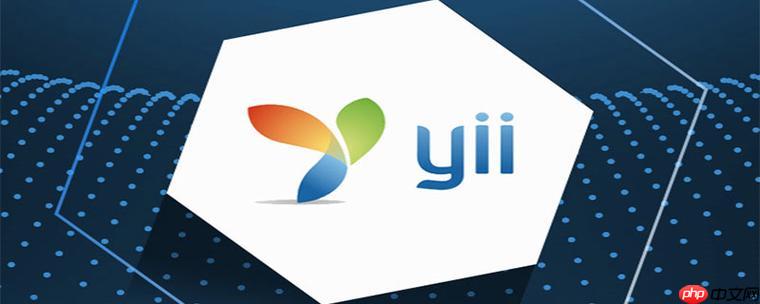首先通过composer安装yiisoft/yii2-elasticsearch扩展;2. 在配置文件中添加elasticsearch组件,设置节点地址等参数;3. 创建继承自yii\elasticsearch\activerecord的模型,定义attributes、index、type和mapping方法;4. 使用模型的save()、find()->query()等方法实现数据的增删改查与搜索;5. 通过batchinsert()或bulk()进行批量操作以提升性能;6. 合理设计mapping,区分text和keyword类型,配置分词器;7. 利用bool查询、filter上下文、聚合和高亮等功能实现复杂搜索需求;8. 解决数据同步问题可采用实时消息队列或定时任务;9. 遇到mapping冲突时应预先创建索引或使用reindex更换结构;10. 优化性能需避免深度分页、使用filter缓存、合理设置分片与副本,并结合yii缓存机制减少重复查询。该方案完整实现了yii框架与elasticsearch的高效集成,支持高性能搜索与数据分析,且具备良好的可维护性与扩展性。

YII框架集成Elasticsearch,简单来说,就是让你的Yii应用能够高效地利用Elasticsearch这个强大的搜索引擎来处理数据检索、分析等任务。它不再是传统数据库那种简单的CRUD操作,而是把焦点放在了全文搜索、复杂聚合和实时数据分析上。通过集成,Yii应用可以把特定数据同步到ES集群,然后利用ES的强大能力来提供比关系型数据库快得多的搜索体验。这通常涉及使用一个官方或社区提供的扩展,将Yii的ORM概念映射到ES的操作上。
在Yii框架中集成Elasticsearch,最常见且推荐的方式是使用官方提供的
yiisoft/yii2-elasticsearch
首先,通过Composer安装扩展:
composer require yiisoft/yii2-elasticsearch
接着,在应用的配置文件(通常是
config/web.php
config/main.php
return [
// ...
'components' => [
// ...
'elasticsearch' => [
'class' => 'yii\elasticsearch\Connection',
'nodes' => [
['http_address' => '127.0.0.1:9200'],
// 根据需要添加更多节点
],
// 'auth' => ['username' => 'elastic', 'password' => 'changeme'], // 如果ES有认证
// 'options' => [
// 'timeout' => 20, // 连接超时时间
// ],
],
],
// ...
];然后,你可以创建一个继承自
yii\elasticsearch\ActiveRecord
Product
namespace app\models;
use yii\elasticsearch\ActiveRecord;
class Product extends ActiveRecord
{
/**
* @return array the list of attributes for this record
*/
public function attributes()
{
// 定义Elasticsearch文档的属性
return ['id', 'name', 'description', 'price', 'category_id', 'created_at'];
}
/**
* 定义索引名称
* @return string
*/
public static function index()
{
return 'products'; // 你的Elasticsearch索引名称
}
/**
* 定义文档类型(ES 7+版本中通常可以省略或设为_doc)
* @return string
*/
public static function type()
{
return '_doc';
}
/**
* 定义索引的映射(mapping)
* @return array
*/
public static function mapping()
{
return [
static::type() => [
'properties' => [
'id' => ['type' => 'integer'],
'name' => ['type' => 'text', 'analyzer' => 'ik_max_word'], // 使用ik分词器
'description' => ['type' => 'text', 'analyzer' => 'ik_max_word'],
'price' => ['type' => 'float'],
'category_id' => ['type' => 'integer'],
'created_at' => ['type' => 'date'],
]
],
];
}
/**
* 创建索引和映射
*/
public static function createIndex()
{
$db = static::getDb();
$command = $db->createCommand();
$command->createIndex(static::index(), [
'body' => [
'mappings' => static::mapping(),
'settings' => [
'number_of_shards' => 1,
'number_of_replicas' => 0,
'analysis' => [ // 如果使用中文分词器,需要在此定义
'analyzer' => [
'ik_max_word' => [
'type' => 'custom',
'tokenizer' => 'ik_max_word',
]
]
]
]
]
]);
}
// 假设你有一个方法来从数据库同步数据到ES
public static function syncFromDatabase($product)
{
$esProduct = new Product();
$esProduct->setAttributes([
'id' => $product->id,
'name' => $product->name,
'description' => $product->description,
'price' => $product->price,
'category_id' => $product->category_id,
'created_at' => $product->created_at,
]);
$esProduct->save(); // 保存到Elasticsearch
}
}现在,你可以像使用普通Yii模型一样来操作Elasticsearch数据了:
// 索引一个新文档
$product = new Product();
$product->id = 1;
$product->name = 'Yii框架实战指南';
$product->description = '一本深入浅出讲解Yii框架开发的书籍。';
$product->price = 59.90;
$product->category_id = 1;
$product->created_at = time();
$product->save(); // 自动索引到Elasticsearch
// 搜索文档
$results = Product::find()->query(['match' => ['name' => 'Yii框架']])->all();
foreach ($results as $item) {
echo $item->name . "\n";
}
// 更新文档
$product = Product::get(1); // 根据ID获取
if ($product) {
$product->price = 49.90;
$product->save();
}
// 删除文档
// Product::get(1)->delete();说实话,第一次接触Elasticsearch这玩意儿,感觉它就像个黑洞,强大但又有点神秘。不过,Yii2的
yiisoft/yii2-elasticsearch
它的核心优势在于,你不需要直接去啃Elasticsearch那套复杂的RESTful API和Query DSL。扩展为你封装了大部分底层细节,你可以像操作关系型数据库模型一样去创建、读取、更新、删除ES文档。这大大降低了学习曲线,让我们可以更快地将ES集成到现有项目中。
具体来说,它提供了以下几个核心功能:
find()
save()
delete()
attributes()
mapping()
query()
match
bool
range
multi_match
batchInsert()
bulk()
在我看来,这个扩展的真正价值在于,它让Elasticsearch不再是一个遥不可及的“大数据”概念,而是Yii应用中一个触手可及、易于集成的强大工具。它将ES的复杂性转化为Yii的优雅,让我们可以把更多精力放在业务逻辑本身,而不是纠结于API细节。当然,它也不是万能的,遇到一些特别定制化的ES功能,可能还是需要深入了解ES的Query DSL,甚至直接使用底层连接去发送请求,但至少它提供了一个非常好的起点。
在Yii2里玩Elasticsearch,数据建模和查询是核心。它不像传统关系型数据库那样有严格的表结构和外键约束,ES更像是文档的集合,但它的“文档”也不是随随便便就能扔进去的,合理的建模能让你的搜索效率翻倍。
数据建模: 在Yii2的
yii\elasticsearch\ActiveRecord
attributes()
mapping()
attributes()
mapping()
name
type => 'text'
ik_max_word
price
float
double
not_analyzed
keyword
举个例子,如果你有一个电商产品,除了基本的名称、描述,可能还有SKU、价格、库存、颜色、尺寸等。一个好的ES模型会这样去考虑:
// ... 在Product模型中
public static function mapping()
{
return [
static::type() => [
'properties' => [
'id' => ['type' => 'integer'],
'sku' => ['type' => 'keyword'], // 精确匹配,不分词
'name' => ['type' => 'text', 'analyzer' => 'ik_max_word', 'fields' => ['raw' => ['type' => 'keyword']]], // text用于搜索,keyword用于排序或聚合
'description' => ['type' => 'text', 'analyzer' => 'ik_max_word'],
'price' => ['type' => 'float'],
'stock' => ['type' => 'integer'],
'colors' => ['type' => 'keyword'], // 多个颜色,作为数组存入,但每个颜色都是keyword
'category_ids' => ['type' => 'integer'], // 多个分类ID
'created_at' => ['type' => 'date', 'format' => 'epoch_second'], // 时间戳格式
]
],
];
}这里
name
fields
name
name.raw
查询实践: Yii2的ES扩展提供了多种查询方式,从简单到复杂:
基本查询:
Product::find()->where(['id' => 1])->one();
term
全文搜索:
Product::find()->query(['match' => ['name' => '智能手机']])->all();
match
复合查询(Bool Query):当你需要组合多个查询条件时,
bool
must
should
filter
must_not
$results = Product::find()->query([
'bool' => [
'must' => [
['match' => ['name' => 'Yii']],
['match' => ['description' => '实战']],
],
'filter' => [
['range' => ['price' => ['gte' => 50, 'lte' => 100]]],
['term' => ['category_ids' => 1]], // 精确匹配分类ID
],
'must_not' => [
['term' => ['stock' => 0]], // 排除库存为0的
]
]
])->all();聚合(Aggregations):这是ES的另一个杀手锏,用于数据分析,比如统计每个分类下的产品数量、计算平均价格、获取某个字段的所有唯一值等。
$query = Product::find();
$query->addAggregate('categories_count', [
'terms' => [
'field' => 'category_ids',
'size' => 10 // 返回前10个分类
]
]);
$result = $query->search();
$categoryAggs = $result['aggregations']['categories_count']['buckets'];
// $categoryAggs现在包含了每个category_id及其对应的文档数量高亮(Highlighting):在搜索结果中高亮匹配的关键词,提升用户体验。
$results = Product::find()->query(['match' => ['description' => 'Yii']])->highlight([
'fields' => [
'description' => new \stdClass() // 空对象表示使用默认高亮参数
]
])->all();
foreach ($results as $item) {
echo $item->name . "\n";
// 访问高亮片段
if (isset($item->highlight['description'])) {
echo implode('...', $item->highlight['description']) . "\n";
}
}在实际操作中,我发现最容易踩坑的是
mapping
text
Elasticsearch的性能优化是个大学问,在Yii2的集成语境下,我们能做的事情主要集中在数据操作和查询策略上。同时,一些常见的问题也需要提前有个心理准备。
性能优化:
save()
delete()
yii\elasticsearch\ActiveRecord::batchInsert()
yii\elasticsearch\Connection
bulk()
// 批量插入示例
$productsData = []; // 假设这是从数据库取出的多条产品数据
foreach ($productsFromDb as $product) {
$productsData[] = [
'id' => $product->id,
'name' => $product->name,
'description' => $product->description,
// ... 其他属性
];
}
Product::batchInsert(Product::index(), Product::type(), $productsData);keyword
text
keyword
text
_source
_all
_source
filter
query
filter
bool
filter
*
match
term
from
size
search_after
scroll
yii\caching\FileCache
yii\caching\MemCache
常见问题应对:
Product::createIndex()
http_address
elasticsearch
以上就是YII框架的Elasticsearch集成是什么?YII框架如何使用ES?的详细内容,更多请关注php中文网其它相关文章!

每个人都需要一台速度更快、更稳定的 PC。随着时间的推移,垃圾文件、旧注册表数据和不必要的后台进程会占用资源并降低性能。幸运的是,许多工具可以让 Windows 保持平稳运行。

Copyright 2014-2025 https://www.php.cn/ All Rights Reserved | php.cn | 湘ICP备2023035733号